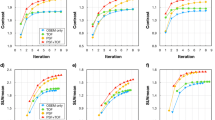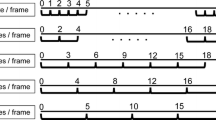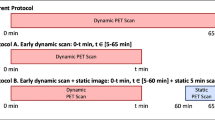Abstract
Introduction
Accurate quantification of tumour tracer uptake is essential for therapy monitoring by sequential PET imaging. In this study we investigated to what extent a reduction in administered activity, synonymous with an overall reduction in repeated patient exposure, compromised the accuracy of quantitative measures using time-of-flight PET/CT.
Methods
We evaluated the effect of reducing the emission count statistics, using a 64-channel GEMINI TF PET/CT system. Experiments were performed with the NEMA IEC body phantom at target-to-background ratios of 4:1 and 10:1. Emission data for 10 s, 30 s, 1 min, 2 min, 5 min and 30 min were acquired. Volumes of interest fitted to the CT outline of the spheres were used to calculate recovery coefficients for each target-to-background ratio and for different reconstruction algorithms. Whole-body time-of-flight PET/CT was performed in 20 patients 62±4 min after injection of 350±40 MBq (range 269–411 MBq) 18F-FDG. From the acquired 2 min per bed position list mode data, simulated 1-min, 30-s and 15-s PET acquisitions were created. PET images were reconstructed using the TOF-OSEM algorithm and analysed for differences in SUV measurements resulting from the use of lower administered activity as simulated by reduced count statistics.
Results
In the phantom studies, overall we identified no significant quantitation bias over a wide range of acquired counts. With acquisition times as short as 10 s, lesions as small as 1 cm in diameter could still be identified. In the patient studies, visual analysis showed that emission scans as short as 15 s per bed position sufficiently identified tumour lesions for quantification. As the acquisition time per bed position decreased, the differences in SUV quantification of tumour lesions increased relative to the 2-min reference protocol. However, SUVs remained within the limits of reproducibility required for therapy monitoring. Measurements of SUVmean within the region of interest were less prone to noise than SUVmax, and with the 30-s per bed position 95% confidence limits were ±11% or ±0.7 SUV.
Conclusion
Short time acquisitions, synonymous with reduced injected activity, performed on a TOF-based PET/CT system are feasible without encountering significant bias. This could translate into clinical protocols using lower administered activities particularly for serial PET studies.








Similar content being viewed by others
References
Weber WA. Positron emission tomography as an imaging biomarker. J Clin Oncol 2006;24(20):3282–92.
Fletcher JW, Djulbegovic B, Soares HP, et al. Recommendations on the use of 18F-FDG PET in oncology. J Nucl Med 2008;49(3):480–508.
Czernin J, Allen-Auerbach M, Schelbert HR. Improvements in cancer staging with PET/CT: literature-based evidence as of September 2006. J Nucl Med 2007;48:78S–88.
Avril NE, Weber WA. Monitoring response to treatment in patients utilizing PET. Radiol Clin North Am 2005;43(1):189–204.
Stahl A, Ott K, Schwaiger M, Weber WA. Comparison of different SUV-based methods for monitoring cytotoxic therapy with FDG PET. Eur J Nucl Med Mol Imaging. 2004;31(11):1471–8.
Weber WA, Figlin R. Monitoring cancer treatment with PET/CT: does it make a difference? J Nucl Med 2007;48 Suppl 1:36S–44.
Boellaard R. Standards for PET image acquisition and quantitative data analysis. J Nucl Med 2009;50(Suppl 1):11S–20.
Karp JS, Surti S, Daube-Witherspoon ME, Muehllehner G. Benefit of time-of-flight in PET: experimental and clinical results. J Nucl Med 2008;49(3):462–70.
Budinger TF. Time-of-flight positron emission tomography: status relative to conventional PET. J Nucl Med 1983;24(1):73–8.
Surti S, Karp JS, Popescu LM, Daube-Witherspoon ME, Werner M. Investigation of time-of-flight benefit for fully 3-D PET. IEEE Trans Med Imaging 2006;25(5):529–38.
Surti S, Karp JS. Experimental evaluation of a simple lesion detection task with time-of-flight PET. Phys Med Biol 2009;54(2):373–84.
Surti S, Kuhn A, Werner ME, Perkins AE, Kolthammer J, Karp JS. Performance of Philips Gemini TF PET/CT scanner with special consideration for its time-of-flight imaging capabilities. J Nucl Med 2007;48(3):471–80.
Popescu LM, Matej S, Lewitt RM. Iterative image reconstruction using geometrically ordered subsets with list-mode data. IEEE Nucl Sci Symp Conf Rec 2004;1–7:3536–40.
Daube-Witherspoon ME, Matej S, Karp JS, Lewitt RM. Application of the row action maximum likelihood algorithm with spherical basis functions to clinical PET imaging. IEEE Trans Nucl Sci 2001;48(1):24–30.
D'Agostino RB, Belanger A, D'Agostino RB Jr. A suggestion for using powerful and informative tests of normality. American Statistician 1990;44(4):316–21.
Hoffman EJ, Huang SC, Phelps ME, Kuhl DE. Quantitation in positron emission computed tomography: 4. Effect of accidental coincidences. J Comput Assist Tomogr 1981;5(3):391–400.
van Velden FH, Kloet RW, van Berckel BN, Lammertsma AA, Boellaard R. Accuracy of 3-dimensional reconstruction algorithms for the high-resolution research tomograph. J Nucl Med 2009;50(1):72–80.
Wang W, Hu Z, Gualtieri EE, et al. Systematic and distributed time-of-flight list mode PET reconstruction. Paper presented at: Nuclear Science Symposium Conference Record, 2006. IEEE, 2006.
Rahmim A, Lenox M, Reader AJ, et al. Statistical list-mode image reconstruction for the high resolution research tomograph. Phys Med Biol 2004;49(18):4239–58.
Weber WA, Ziegler SI, Thodtmann R, Hanauske AR, Schwaiger M. Reproducibility of metabolic measurements in malignant tumors using FDG PET. J Nucl Med 1999;40(11):1771–7.
Krak NC, Boellaard R, Hoekstra OS, Twisk JW, Hoekstra CJ, Lammertsma AA. Effects of ROI definition and reconstruction method on quantitative outcome and applicability in a response monitoring trial. Eur J Nucl Med Mol Imaging 2005;32(3):294–301.
Nahmias C, Wahl LM. Reproducibility of standardized uptake value measurements determined by 18F-FDG PET in malignant tumors. J Nucl Med 2008;49(11):1804–8.
Boellaard R, Krak NC, Hoekstra OS, Lammertsma AA. Effects of noise, image resolution, and ROI definition on the accuracy of standard uptake values: a simulation study. J Nucl Med 2004;45(9):1519–27.
Torizuka T, Tanizaki Y, Kanno T, et al. Single 20-second acquisition of deep-inspiration breath-hold PET/CT: clinical feasibility for lung cancer. J Nucl Med 2009;50(10):1579–84.
Conflicts of interest
T.B. is CEO of cmi-experts and has no conflicts of interest to report. A.K. and J.G. are employed by Philips Healthcare and have no conflicts of interest to report.
Author information
Authors and Affiliations
Corresponding author
Rights and permissions
About this article
Cite this article
Murray, I., Kalemis, A., Glennon, J. et al. Time-of-flight PET/CT using low-activity protocols: potential implications for cancer therapy monitoring. Eur J Nucl Med Mol Imaging 37, 1643–1653 (2010). https://doi.org/10.1007/s00259-010-1466-5
Received:
Accepted:
Published:
Issue Date:
DOI: https://doi.org/10.1007/s00259-010-1466-5




